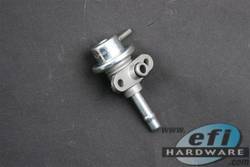The car owners often overlook a fuel pressure regulator, but it is one of the essential parts of the car. It is used to maintain the constant pressure of fuel in vehicles. In case of its malfunctioning or any defect in this part, the overall performance of the car can get affected, and you can face some severe issues. The article will tell you briefly about the parts of the fuel pressure regulator, its functioning & importance.

Parts Of The Fuel Pressure Regulator
Fuel pressure regulator comprises of 8 major components that are as follows:
1. Pressure adjust nuts
This is found at the top of the regulator. It alerts the preload on the spring. If the preload is increased, the pressure will also increase.
2. 6mm plastic hose
It is a vacuum port that provides the boosts or the vacuum pressure at the top of the diaphragm.
3. Stainless spring
It applies pressure to the diaphragm; this pressure is known as the base pressure. It is set on the engine.
4. Diaphragm membrane
It is usually made of rubber. It is used to seal the regulator. This diaphragm membrane is responsible for moving the bypass valve. With this movement, the fuel pressure is altered. Nowadays, you can find electronic fuel pressure regulators where such diaphragms are not seen, and it can regulate the fuel pressure automatically according to the horsepower of your car.
5. Bypass valve
It is attached to the diaphragm. It is used to control the flow to the return port. It can pass the pressure to the engine because each engine needs different kinds of oil pressure and you need to maintain this measure to run your car smoothly.
6. Fuel inlet
It handles the fuel rail. Some regulators can have two or more inlets to control the engine with more than one fuel rail.
7. Excess fuel port
It returns the bypassed fuel to the fuel tank.
8. Pressure port
It attaches a fuel pressure gauge for digital output.
The Functioning Of The Fuel Pressure Regulator
The regulator is attached to the vacuum hose, and it is the last part of the engine to receive the fuel. It also supplies additional pressure against the spring and helps in decreasing the level of the fuel pressure. The pressure of the spring is specified for the exact amount of the pressure. This pressure is used to fill the fuel that is required for the functioning of the vehicle. In case there is any additional fuel that is drawn from the fuel tank, it is again sent back through the return line. During this process, the exact pressure of the spring is sustained. When the vehicle starts, the flow of the fuel in the regulator is augmented, and the vacuum drops.
Why Is The Fuel Pressure Regulator Important?
1. It is used to maintain the proper fuel pressure in the car. Any defect in the Fuel pressure regulator will affect the pressure of the engine, and it will result in the leakage of the fuel or and further it will lead to malfunctioning of the engine.
2. Fuel pressure regulator also lets the fuel injection system perform effectively. It is also responsible for the overall performance of the vehicle.
Apart from that, the regulator get damage, it will result in pumping excess fuel or less fuel to the injectors than required. Be it any case; it will affect the functioning of the car. If your fuel is being pumped at the high pressure, the excess fuel is supplied to the injectors that later results in the wastage of the fuel.

